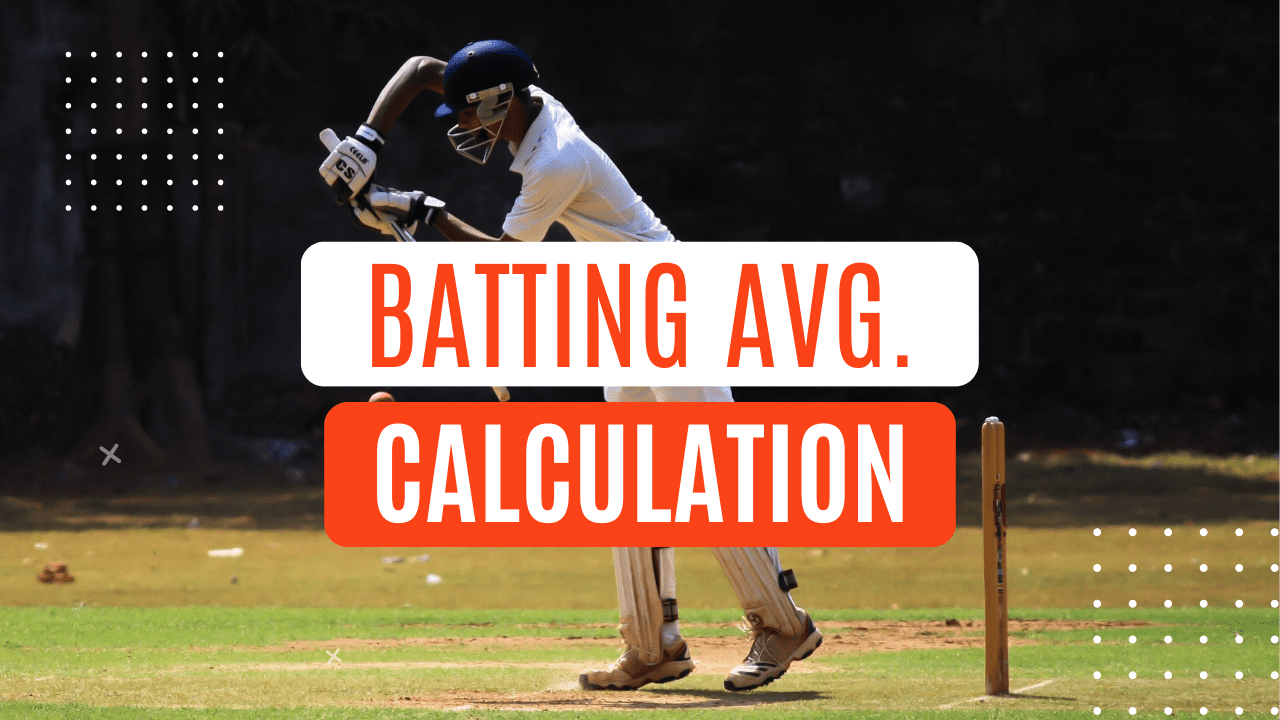Cricket is a fun sport with excellent players and cheering fans. But how do you know who the best hitters are? There’s a secret number called the batting average that tells you! It shows how many runs a player usually scores before they get out.

Batting average is a statistic that separates the legends like Sir Viv Richards (career average: 50.88) from the promising Rishabh Pant (current average: 43.67).We will learn how to figure out this number and use a famous player, Virat Kohli, as an example.
[Disclaimer: All statistics used in this article are subject to change as players compete in more matches.]
Table of Contents
But how is batting average calculated in cricket, and what nuances lie hidden within the numbers? Buckle up, aspiring analysts, for a comprehensive explanation with real-life examples packed with stats and pro tips!
The Building Blocks:
Imagine Rohit Sharma facing fiery deliveries. Every run he scores adds to his total runs. If he stays till the innings end, like his majestic 264 against Sri Lanka in 2014, he’s not out.
But sometimes, like in his 136 against Australia in 2018, he might get caught or bowled, adding to his innings played.
The thrill of a batsman smashing boundaries, the agony of a dismissal – cricket is a sport brimming with stats that paint a picture of a player’s prowess. But have you ever wondered how a batsman’s batting average is calculated? Fear not, cricket fanatics, for this article will unveil the formula behind this crucial stat!
Cracking the Code: The Batting Average Formula
Think of batting average as a measure of a batsman’s consistency. It’s calculated by dividing the total number of runs a batsman scores by the number of times they’ve been dismissed (out). Here’s the secret sauce:
- Batting Average = Total Runs Scored / Number of Times Dismissed
For example, imagine a batsman with 450 runs in 9 innings and 4 dismissals. Their batting average would be:
- Batting Average = 450 runs / 4 dismissals = 112.5 runs/dismissal
Beyond the Basics: A Dip into the Details
The world of cricket averages is a fascinating one, with a few things to keep in mind:
- Not Outs Don’t Count: If a batsman remains unbeaten (not out) in an innings, it doesn’t count as a dismissal. So, their average might be slightly inflated compared to their true run-scoring ability.
- Innings Played Matter: A batsman with many innings under their belt will generally have a more stable average than someone new to the crease.
- A World of Averages: There are various batting averages you might encounter, like career average (entire career) or test match average (focusing just on test matches). Let’s explore some popular searches directly related to batting averages and provide answers to quench your cricketing curiosity:
The Formula Explained:
Now, let’s unlock the magic formula:
Batting Average = Total Runs Scored / (Innings Played – Not Outs)
Virat Kohli Batting Average Example:

Using the formula, Let’s calculate ODIs batting average = Total Runs Scored / (Innings Played – Not Outs), we get:
Average = 13,848 runs / (280 innings – 44 not outs)
= 13,848 runs / 236 dismissals
= 58.677 ≈ 58.68*(rounded to two decimal places)
Meaning of 58.68* Average:
- Context matters: Remember, this average might be from a specific period in his career or a particular type of match situation. Kohli’s average in different stages of his career or in different formats (Tests, T20s) will vary.
- Consider strike rate: Averages alone don’t tell the whole story. Kohli’s strike rate in ODIs is 93.59, indicating a good balance between scoring runs and facing deliveries.
Overall:
- Virat Kohli is a world-class batsman with a proven track record.
- An average of 58.68 proves him one of the greatest ODI players of all time.
- To truly understand his batting prowess, analyze various averages, strike rates, and impact on matches across different formats and situations.
I hope this explanation clarifies the meaning of average in the Virat Kohli example and empowers you to analyze cricket stats more effectively!
Reminder: The runs, innings, and not-out data above are sourced from Cricbuzz.com as of February 2024. These statistics are subject to change as Virat Kohli plays more matches.
Understanding the Nuances:
A higher average suggests consistency. Steve Smith’s Test average of 57.52 speaks volumes! But remember, strike rate matters too. Jos Buttler’s high strike rate (117.11) with a 39.54 average in ODIs shows his aggressive style.
However, context is key. Don’t directly compare a Test average (50-150 overs per innings) to a T20 average (20 overs per innings).

Pro Tips:
- Dig deeper: Explore formats and conditions. A player’s average in bouncy Australian pitches (e.g., David Warner: Test average 44.6) might differ from flat Indian pitches (e.g., Rohit Sharma: Test average 45.5).
- Consider the era: Compare players within their eras, not across generations. The game evolves, and so do scoring rates and bowling styles (e.g., Don Bradman’s legendary Test average of 99.94 in the 1930s and 40s wouldn’t be directly comparable to modern players).
- Look beyond averages: Analyze strike rates, partnerships built, and impact on matches. Remember, cricket is more than just runs! (e.g., Jos Buttler’s strike rate and ability to finish matches in T20s adds value beyond his average).
Context is Key:
Remember, statistics don’t paint the whole picture. Consider:
- Match Format: Comparing players across Test, ODI, and T20 requires different perspectives.
- Pitch and Conditions: A batsman’s performance can be impacted by pitch behavior and weather.
- Opposition Quality: Facing stronger bowling attacks presents a bigger challenge. That is the reason why many players considers Sachin Tendulkar as the greatest batsman ever.
Test Your Knowledge: Cricket Statistics Deep Dive
- 99 Average in Test Cricket: An incredible feat! This search might lead you to legends like Sir Donald Bradman, the only batsman to average over 99 runs per dismissal in Test Cricket history.
- Highest Test Cricket Batting Average: The current holder of the highest test batting average is Sir Donald Bradman with a staggering 99.94.
- Current Test Cricket Batting Average: As of May 2nd, 2024, the ICC ranking for the top test batsman with the highest current average is held by Marnus Labuschagne from Australia. You can find the latest rankings on the ICC website (https://www.icc-cricket.com/).
- Test Cricket Averages Current Players: Explore the ICC player rankings (https://www.icc-cricket.com/) to see how all the current test stars stack up against each other in terms of batting average.
- Best Test Cricket Batting Averages: For a broader historical perspective, search for resources like Wisden Cricket or Cricinfo that list the highest batting averages throughout Test Cricket history.
- Cricket Test Match Batting Averages: This search can lead you to various sources with information on test match batting averages for players across eras. ESPNcricinfo (https://www.espncricinfo.com/) is a great resource for this.
- Batsman Average Calculator: Put your knowledge to the test! Search online for batsman average calculators. These tools allow you to practice with real data from websites like Cricinfo or ESPNcricinfo, or even create fun hypothetical scenarios to see how batting averages change.
- Highest ODI Average Batsman List: Curious about batting prowess in One Day Internationals (ODIs)? Search for lists featuring the ODI batting greats with the highest averages. Resources like Wisden Cricket or Cricinfo will have this information.
By understanding batting averages and exploring these related searches, you’ll gain a deeper appreciation for the art of batsmanship and the rich world of cricket statistics!
Final Words:
So, batting averages are like quick pictures of how well a player hits. They don’t tell the whole story, though! Sometimes players have fantastic games, and occasionally not-so-great ones. As the game changes, we get even more exciting players and stories.
The best part of cricket is that it’s not just about the numbers – it’s about how much the player helps the team win! Now that you understand this, you can watch your favorite players and determine what makes them unique.
Read More: How to play slower ball in cricket?
James Paul is a former first-class cricketer and passionate cricket analyst. His decades of experience on the field and his love for the game shape his insights into the strategies and personalities that define world-class cricket.
